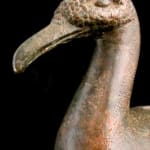Asante Bronze Sculpture of a Bird, 18th Century CE - 19th Century CE
Bronze
5.5 x 11.25
PF.5853
Further images
Traditional notions of primitivism formerly pervasive in the study of African art disregard the possibility of an art that is realistic, that is derived from a first hand observation of...
Traditional notions of primitivism formerly pervasive in the study of African art disregard the possibility of an art that is realistic, that is derived from a first hand observation of nature, and that seeks to emulate forms as we see them. Of course, this notion is inflicted upon the art so that is conforms and reflects the cultural prejudices of European colonials. Even as basic survey of the art of the continent reveals a rich artistic heritage that rivals that of the Renaissance. Cultures such as the Benin and Ife tribes achieved a level of sculptural mastery that is as evocative and naturalistic as the best European art. This striking sculpture of a water bird reveals the true breadth and scope of African art. The master sculptor has captured the essence of the bird, translating each individual feather into bronze. Perhaps the most impressive aspect of the sculpture is the variety of textures that the artist has been able to replicate from the fluffy coat of feathers to the leathery folds of flesh around the eyes and beak. Countless numbers of minute indentations poked into the bronze help achieve the effect of the softness of the birds feathery coat. The bird stands alert as if consciously posing upon a base decorated with an interwoven motif. This sculpture is a true masterpiece for it is not a mimetic repetition of the natural world but an artistic observation and reinterpretation. Surely no bird would stand as idle and stiff as this, yet the artist creates a sense of beauty and majesty that characterizes such a noble creature.









